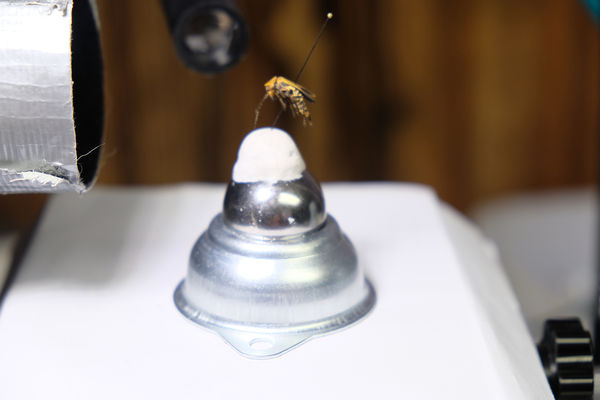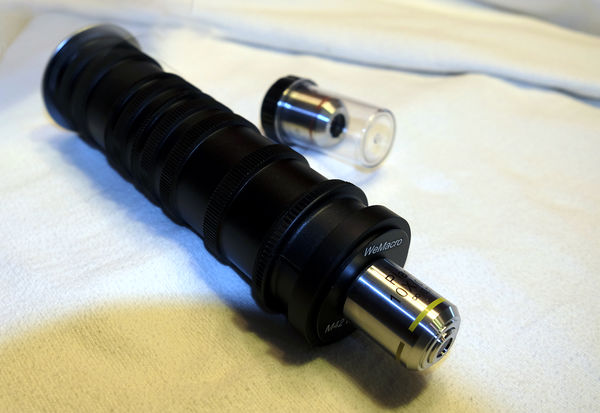Crane Fly
Jul 28, 2020 09:40:46 #
sippyjug104 wrote:
I truly enjoy sharing what I do and how I do it an... (show quote)
Thank you so much for sharing your expertise. I truly enjoy looking at your stunning photos of tiny things. Your knowledge and experience are priceless for anyone interested in this genre and especially to a neophyte such as I. Examining the photo of the setup you use, may I ask to know more about the staging area. I see the cup that you diffuse light through. What are all the black knobs and handles about? And where do you put the insect? The bellows with the reversed lens at the end must mean that the lens surface is exceedingly close to the insect. I appreciate any info you can teach me so I can learn more.
NMY
Jul 28, 2020 10:19:19 #
sscnxy wrote:
Thank you so much for sharing your expertise. I t... (show quote)
Thanks for asking and providing me an opportunity to share. The 'black thing with knobs' is what is called a "magic arm" that allows for holding whatever is attached to it and any turn or angle needed.
https://www.amazon.com/UTEBIT-Articulating-Friction-Photography-Monitor/dp/B07GMZRT7L/ref=sr_1_18?dchild=1&keywords=magic+arm&qid=1595944739&sr=8-18
I place the specimen on a pin made for mounting insects which is very, very thin and painted black. It is a common essential for insect collectors. I bought a furniture caster for $2.50 from the hardware store and I took the ball bearing out and set it on top of the caster housing. I place a dab of plasticine modeling clay on it to stick the insect mounted on its pin. This allows me to rotate the specimen to position it in front of the camera as needed. Another method that I use is to put the dab of modeling clay on the end of the magic arm and position the specimen where I need it. When I use the caster as a positioner I place it on the little laboratory jack to raise and lower the specimen in front of the camera.
I also use a sliding work table that is intended to be used for a drill press or milling machine although for $40 no serious machinist would consider using it however it works perfect for my needs. It the thing with the green base and it adjusts forward and back as well as left and right.
You are correct about how close the working distance is between the lens and the subject. More magnification means closer distance and when I use microscope objectives as the lens the subject is within a few millimeters of the end of the lens. Of course if you think about how microscopes are used its the same thing where the objective nearly touches the specimen slide. This is actually no difference for it is a function of the lens or objective. Attached is a picture of my setup for using a microscope objective as the camera's lens.
Here's a link to close up photography which I have shared several times that is super fantastic packed with information. There's a lot of info on this website and the tab that I've linked is for the microscope objective and how inexpensive and simple it is to do.
https://www.closeuphotography.com/seventeen-dollar-plan-4x-objective/
I truly hope that you have an opportunity to enjoy this passion with me for the world around us is amazing when viewed so differently. Even simple table salt is a new adventure. - Enjoy, Sippy.
Jul 29, 2020 09:15:37 #
Sippy,
You're an amazing colleague and a wonderful teacher. I truly appreciate all your tips and thanks for sharing the photos and web pages. I'm trying to absorb as much as I can, but the older I get, the less storage space I have in my skull. Still trying, tho. Take care and I'll be checking your posts often.
NMY
You're an amazing colleague and a wonderful teacher. I truly appreciate all your tips and thanks for sharing the photos and web pages. I'm trying to absorb as much as I can, but the older I get, the less storage space I have in my skull. Still trying, tho. Take care and I'll be checking your posts often.
NMY
Jul 31, 2020 21:27:56 #
Jul 31, 2020 21:32:28 #
If you want to reply, then register here. Registration is free and your account is created instantly, so you can post right away.



